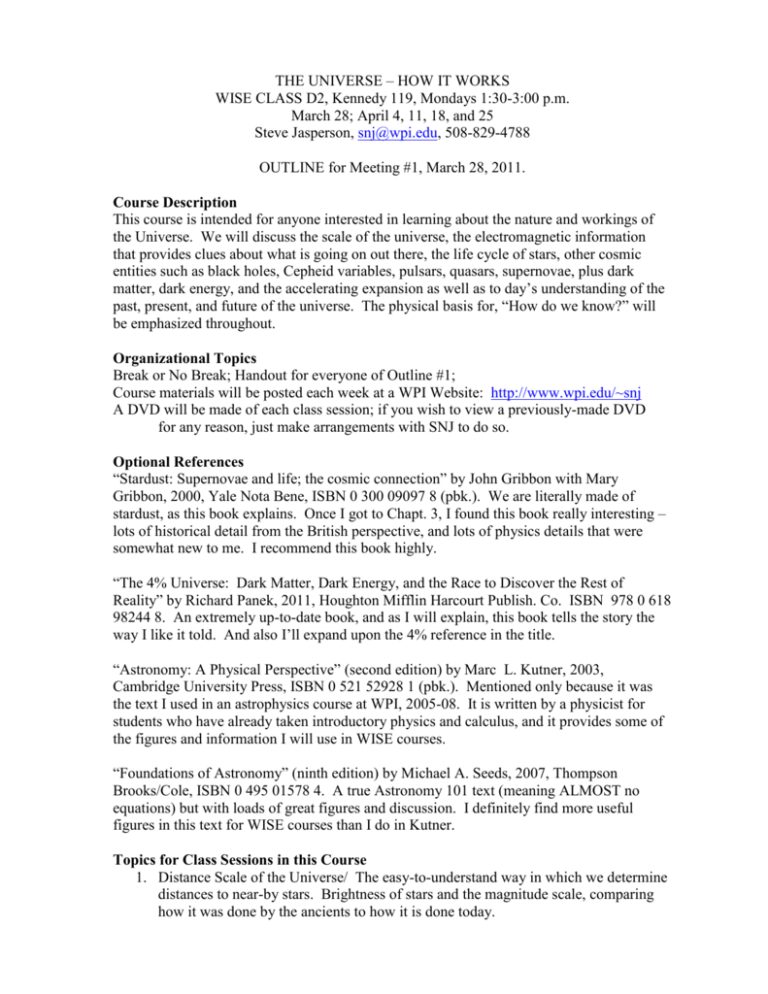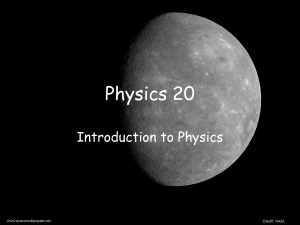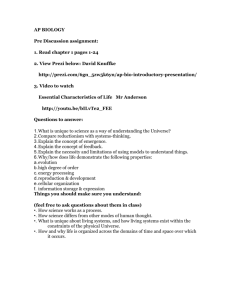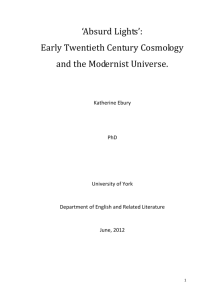THE ART AND SCIENCE OF SPEECH AND SONG
advertisement

THE UNIVERSE – HOW IT WORKS WISE CLASS D2, Kennedy 119, Mondays 1:30-3:00 p.m. March 28; April 4, 11, 18, and 25 Steve Jasperson, snj@wpi.edu, 508-829-4788 OUTLINE for Meeting #1, March 28, 2011. Course Description This course is intended for anyone interested in learning about the nature and workings of the Universe. We will discuss the scale of the universe, the electromagnetic information that provides clues about what is going on out there, the life cycle of stars, other cosmic entities such as black holes, Cepheid variables, pulsars, quasars, supernovae, plus dark matter, dark energy, and the accelerating expansion as well as to day’s understanding of the past, present, and future of the universe. The physical basis for, “How do we know?” will be emphasized throughout. Organizational Topics Break or No Break; Handout for everyone of Outline #1; Course materials will be posted each week at a WPI Website: http://www.wpi.edu/~snj A DVD will be made of each class session; if you wish to view a previously-made DVD for any reason, just make arrangements with SNJ to do so. Optional References “Stardust: Supernovae and life; the cosmic connection” by John Gribbon with Mary Gribbon, 2000, Yale Nota Bene, ISBN 0 300 09097 8 (pbk.). We are literally made of stardust, as this book explains. Once I got to Chapt. 3, I found this book really interesting – lots of historical detail from the British perspective, and lots of physics details that were somewhat new to me. I recommend this book highly. “The 4% Universe: Dark Matter, Dark Energy, and the Race to Discover the Rest of Reality” by Richard Panek, 2011, Houghton Mifflin Harcourt Publish. Co. ISBN 978 0 618 98244 8. An extremely up-to-date book, and as I will explain, this book tells the story the way I like it told. And also I’ll expand upon the 4% reference in the title. “Astronomy: A Physical Perspective” (second edition) by Marc L. Kutner, 2003, Cambridge University Press, ISBN 0 521 52928 1 (pbk.). Mentioned only because it was the text I used in an astrophysics course at WPI, 2005-08. It is written by a physicist for students who have already taken introductory physics and calculus, and it provides some of the figures and information I will use in WISE courses. “Foundations of Astronomy” (ninth edition) by Michael A. Seeds, 2007, Thompson Brooks/Cole, ISBN 0 495 01578 4. A true Astronomy 101 text (meaning ALMOST no equations) but with loads of great figures and discussion. I definitely find more useful figures in this text for WISE courses than I do in Kutner. Topics for Class Sessions in this Course 1. Distance Scale of the Universe/ The easy-to-understand way in which we determine distances to near-by stars. Brightness of stars and the magnitude scale, comparing how it was done by the ancients to how it is done today. 2. Almost everything we can determine about the universe comes from electromagnetic (EM) radiation. In this class we will discuss the enormous range of the EM spectrum, as well as the transmission characteristics of the atmosphere for each region of the EM spectrum. This will lead to further discussion of strategies for teasing out information about the nature of the universe from each portion of the EM spectral range. 3. In Lecture 3 (L3) we will devote most of our time on the subject of the energy source responsible for stars shining brightly, how stars form, and the HertzsprungRussell (H-R) means of characterizing all stars. 4,5 Other cosmic entities, such as black holes, Cepheid variables, pulsars, quasars, and supernovae. We will also discuss the significance of Cosmic Background Radiation, dark matter, dark energy, and background details about The 4% Universe.. Outline of Today’s Discussion Organizational Topics How do Optional References fit in? And what is the mathematical expectation? SNJ’s background leading to this course This course in WISE perspective Olbers’s Paradox (Why is the night sky dark?). (Heinrich Olbers, physician and astronomer discussed this situation in 1826, but through an accident of scholarship on the part of modern cosmologists, earlier folks were not credited. Several earlier astronomers were not given proper credit, such as Thomas Diggs (1576); Johannes Kepler (1610), and Edmund Halley (1721). Even Edgar Allen Poe (1848) proposed as a solution that the universe was not infinitely old. He was correct!!!) The size of the universe The parallax method of determining distances to near-by stars The magnitude scale invented by Hipparcus (circa 150 bce) The satellite Hipparcos launched in 1989 The concept of Absolute Magnitude The Planck equation describing cavity (or blackbody) radiation, and the significance thereof Invitation Should you have another topic you would like have discussed in this class but you do not see it listed on this Outline 1 page, you are welcome to call or e-mail me about including discussion of that topic before the end of this course, and I will be happy to consider your request. A Not-To-Miss Opportunity The folks at NASA have a new picture every day of something OUT THERE (often WAY OUT THERE), along with a paragraph explaining what you are looking at. If you are into URLs, then type http://apod.nasa.gov/apod/ into the address line of your computer, or if you are like me and can never remember the URL, then Google ‘astronomy picture of the day’, and you will get about 3 million hits. But the first listing will be good enough. If you want to look at back pictures, click the “Archive” link. I especially like The Andromeda Galaxy in Infrared from October 20, 2005.









